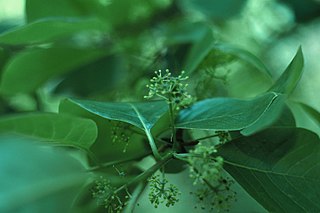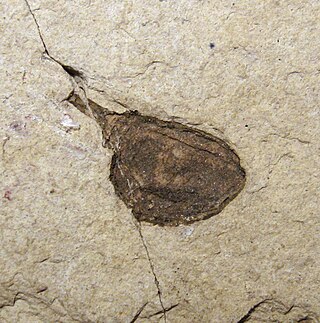
Tupelo, genus Nyssa, is a small genus of deciduous trees with alternate, simple leaves. It is sometimes included in the subfamily Nyssoideae of the dogwood family, Cornaceae, but is placed by other authorities in the family Nyssaceae. In the APG IV system, it is placed in Nyssaceae.

Florissantia is an extinct genus of flowering plants in the Malvaceae subfamily Sterculioideae known from western North America and far eastern Asia. Flower, fruit, and pollen compression fossils have been found in formations ranging from the Early Eocene through to the Early Oligocene periods. The type species is Florissantia speirii and three additional species are known, Florissantia ashwillii, Florissantia quilchenensis, and Florissantia sikhote-alinensis.
Carya washingtonensis is an extinct species of hickory nut in the walnut family Juglandaceae. The species is solely known from the Miocene sediments exposed in Kittitas County near Ellensburg, Washington.
Acer clarnoense is an extinct maple species in the family Sapindaceae described from a series of isolated fossil leaves and samaras. The species is known from the late Eocene sediments exposed in the state of Oregon in the US. It is one of several extinct species placed in the living section Macrantha.
Cornus piggae is an extinct species of dogwood known from fossil fruits found in Late Paleocene sediments exposed in the US state of North Dakota. C. piggae is one of three extinct species placed in the Cornus subgenus Cornus based on fossil fruit morphology. The other two species, C. ettingshausenii and C. multilocularis are known from pyritized fruits found in sediments of the London Clay in England. C. piggae is the only North American fruit species yet described and is also the oldest described species in Cornus subgenus Cornus.

Eucommia montana is an extinct species of flowering plant in the family Eucommiaceae. E. montana is known from fossil fruits found in Eocene deposits of the northwestern United States southeastern British Columbia south to Oregon and east to Montana and Colorado. E. montana is one of five described fossil species from North America assigned to the modern genus Eucommia. The other species are E. constans, E. eocenica, E. jeffersonensis, and E. rowlandii.
Taxus masonii is an extinct species of conifer in the yew family, Taxaceae, solely known from the middle Eocene sediments exposed in north central Oregon. The species was first described from a series of isolated fossil seeds in chert.
Torreya clarnensis is an extinct species of conifer in the yew family Taxaceae solely known from the middle Eocene sediments exposed in north central Oregon. The species was first described from a series of isolated fossil seeds in chert.
Diploporus is an extinct genus of conifers in the yew family Taxaceae, containing the single species Diploporus torreyoides known from the middle Eocene of north central Oregon and the Late Paleocene of south central North Dakota. The species was first described from a series of isolated fossil seeds in chert.
Actinidia oregonensis is an extinct species of flowering plants in the kiwifruit family, Actinidiaceae, solely known from the middle Eocene sediments exposed in north-central Oregon. The species was first described from a series of isolated fossil seeds in chert.
Rhus rooseae is an extinct species of flowering plants in the sumac family, Anacardiaceae, solely known from the middle Eocene sediments exposed in north central Oregon. The species was first described from a series of isolated fossil seeds in chert.
Paleopanax is an extinct genus of flowering plant in the Ginseng and Ivy family, Araliaceae, containing the single species Paleopanax oregonensis. The species is solely known from the middle Eocene sediments exposed in north central Oregon and was first described from a series of isolated fossil fruits in siltstones.
Coryloides is an extinct genus of flowering plants in the hazelnut family, Betulaceae, containing the single species Coryloides hancockii. The species is solely known from the middle Eocene sediments exposed in north central Oregon and was first described from a series of isolated fossil nuts in cherts.
Kardiasperma is an extinct genus of flowering plants in the hazelnut family, Betulaceae, containing the single species Kardiasperma parvum. The species is solely known from the middle Eocene sediments exposed in north central Oregon and was first described from a series of isolated fossil nuts in cherts.
Cornus clarnensis is an extinct species of flowering plant in the dogwood family, Cornaceae, solely known from the middle Eocene sediments exposed in north central Oregon. The species was first described from a series of isolated fossil seeds in chert.

Langeria is an extinct genus of flowering plants in the family Platanaceae containing the solitary species Langeria magnifica. Langeria is known from fossil leaves found in the early Eocene deposits of northern Washington state, United States and similar aged formations in British Columbia, Canada.

Ulmus okanaganensis is an extinct species of flowering plant in the family Ulmaceae related to the modern elms. The species is known from fossil leaves, flowers, and fruits found in the early Eocene deposits of northern Washington state, United States and similar aged formations in British Columbia, Canada.
Paraconcavistylon is an extinct genus of flowering plant in the family Trochodendraceae comprises a single species, Paraconcavistylon wehrii. The genus is known from fossil fruits and leaves found in the early Eocene deposits of northern Washington state, United States, and southern British Columbia, Canada. The species was initially described as a member of the related extinct genus Concavistylon as "Concavistylon" wehrii, but subsequently moved to the new genus Paraconcavistylon in 2020 after additional study.

Pteronepelys, sometimes known as the winged stranger, is an extinct genus of flowering plant of uncertain affinities, which contains the one species, Pteronepelys wehrii. It is known from isolated fossil seeds found in middle Eocene sediments exposed in north central Oregon and Ypresian-age fossils found in Washington, US.

Fagus langevinii is an extinct species of beech in the family Fagaceae. The species is known from fossil fruits, nuts, pollen, and leaves found in the early Eocene deposits of South central British Columbia, and northern Washington state, United States.






